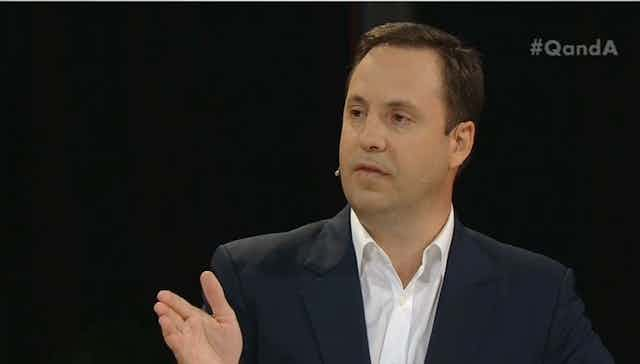The Conversation is fact-checking claims made on Q&A, broadcast Mondays on the ABC at 9:35pm. Thank you to everyone who sent us quotes for checking via Twitter using hashtags #FactCheck and #QandA, on Facebook or by email.
We’ve had 25 years of continuous economic growth, the only country in the world with a period of growth that long. – Trade minister Steven Ciobo, speaking on Q&A, May 31, 2016.
Economic management is shaping up as a key election battleground, and the Coalition has been especially keen to keep the focus on the economy.
Trade minister Steven Ciobo told Q&A viewers that Australia has had 25 years of continuous economic growth, and is the only country in the world with a period of growth that long.
Is that right?
Checking the source
A spokesman for Steven Ciobo told The Conversation that Ciobo misspoke on Q&A. The spokesman said by email that:
Mr Ciobo omitted the world developed, he meant to say “developed country”.
That clarification does improve the accuracy of his statement quite considerably. Let’s test his two statements separately.
25 years of continuous economic growth?
Australia entered a period of low and sometimes negative economic growth in 1989. The last period where growth was negative was June 1991 (for the quarter-over-quarter growth), and December 1991 (for the year-over-year growth).
I would argue that the weak growth through 1991 means that you can’t say that the economy recovered and was growing until 1992.
So on that definition, we have had about 24.5 continuous growth – which is close enough to the Ciobo’s figure of 25 years.
It is true we are in our 25th year of consecutive economic growth. That’s how it was phrased in Austrade’s 2016 Why Australia Benchmark Report, which noted that:
Australia is not only entering its 25th year of consecutive growth, the country is expected to realise annual real GDP growth of 2.9% between 2016 and 2020 – the fastest of any major advanced economy in the world.
The only country in the world?
As the minister’s spokesman said, Ciobo accidentally omitted the word “developed” from his statement.
It is true that all of the other 33 member countries in the Organisation for Economic Co-operation and Development (OECD) have had a period of negative GDP growth since 1991, with most going into recession during the Global Financial Crisis.
It is notable that the dip in growth during the GFC was smaller for the Group of 20 (G20) major economies than for the OECD, and the reason for this is that many emerging markets did not go into recession.
It is not true to say, as the minister accidentally did, that Australia is the only country in the world with a period of growth that long. The chart below shows Australia’s growth next to the G20, OECD, India and China.

The chart shows that China and India, the two most important emerging economies, also have had positive growth in GDP in the past 25 years. It is now more than 25 years since both countries began their economic reform programs, and both countries have enjoyed very strong economic growth over this period.
Verdict
The statement that Australia has had 25 years of continuous economic growth is mostly correct.
The statement that Australia is the only country in the world to have had such a period of unbroken growth is incorrect. But it’s true Australia is the only one out of 34 OECD member countries to have had positive economic growth since 1991. – Mark Crosby
Review
The FactCheck takes the right approach of first confirming the Australian data, which show that there was effectively 25 years of uninterrupted positive growth in real GDP on a quarter-to-quarter basis.
Then it takes the right approach of looking at obvious counter-examples to the statement about Australia being the “only country in the world” with such a long period of uninterrupted positive growth. China immediately came to my mind too.
China is an important counter-example because it addresses the potential caveat that developed economies account for most of world’s economic activity and, therefore, “in the world” might somehow be approximately correct. China may be an emerging economy, but its GDP is now almost two-thirds the size of US GDP. So ignoring it would be a mistake.
It is also worth noting that positive real GDP growth is not the be-all and end-all when evaluating the state of the economy. We might well care more about growth in real GDP per person: on that measure, Australia has had a number of quarters of negative growth during the last 25 years. Also, the Australian unemployment rate increased dramatically by almost two percentage points during the GFC. So a strict focus on quarterly real GDP growth is probably too narrow when thinking about how the overall economy did over the past 25 years.
All in all, I agree with the verdict. – James Morley

